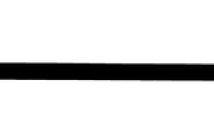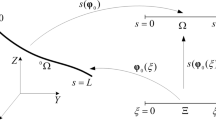Abstract
The paper deals with the conceptual design of a beam under bending. The common problem of designing a beam in a state of pure bending is discussed in the framework of Pareto-optimality theory. The analytical formulation of the Pareto-optimal set is derived by using a procedure based on the reformulation of the Fritz John Pareto-optimality conditions. The shape of the cross section of the beam is defined by a number of design variables pertaining to the optimization process by means of efficiency factors. Such efficiency factors are able to describe the bending properties of any beam cross section and can be used to derive analytical formulae. Design performance is determined by the combination of cross section shape, material and process. Simple expressions for the Pareto-optimal set of a beam of arbitrary cross section shape under bending are derived. This expression can be used at the very early stage of the design to choose a possible cross section shape and material for the beam among optimal solutions.




Similar content being viewed by others
References
Arora JS (2004) Introduction to optimal design. Elsevier Academic Press, UK
Askar SS, Tiwari A (2009) Finding exact solutions for multi-objective optimization problems using a symbolic algorithm. In: Proceedings of the IEEE congress evol. comput., pp 24–30
Ashby MF (2011) Materials selection in mechanical design, 4th edn. Butterworth-Heinemann, UK
Banichuk NV (1990) Introduction to optimization of structures. Springer, New York
Banichuk NV, Ragnedda F, Serra M (2002) Optimum shapes of bar cross-sections. Struct Multidiscip Optim 23:222–232
Benoist J (1998) Connectedness of the efficient solutions for vector maximization problems. J Optim Theor Appl 96(3)
Bendsoe MP, Sigmund O (2003) Topology optimization: theory, methods and applications. Springer, Berlin
Bjorck A (1996) Numerical methods for least squares problems. Society for Industrial and Applied Mathematics, Philadelphia U.S.A.
Erfani T, Utyuzhnikov SV, Kolo B (2013) A modified directed search domain algorithm for multi-objective engineering and design optimization. Struct Multidiscip Optim:1–13
EN-1993-1-1 (2005) EN 1993-1-1 Eurocode3: design of steel structures-Part 1-1: general rules and rules for buildings
Gobbi M, Levi F, Mastinu G (2005) An application of multi-objective stochastic optimisation to structural design. Struct Multidiscip Optim 29(4):272–284
Gobbi M, Levi F, Mastinu G, Previati G (2015) On the analytical derivation of the Pareto-optimal set with applications to structural design. Struct Multidiscip Optim 51(3):645–657
Gobbi M, Mastinu G (2001) On the optimal design of composite material tubular helical springs. Meccanica 36(5):525– 553
Kim DS, et al. (2001) Counterexample and optimality conditions in differentiable multi-objective programming. J Optim Theory Appl 109(1):187–192
Levi F, Gobbi M (2006) An application of analytical multi-objective optimization to truss structures. (AIAA 2006–6975), 11th AIAA/ISSMO multidisciplinary analysis and optimization conference, Portsmouth, Virginia
Marusciac I (1982) On the Fritz John type optimality criterion in multi-objective goal programming. Revue d’Analyse Numerique et de Theorie de l’Approximation 11(1–2)
Mastinu G, Gobbi M, Miano C (2006) Optimal design of complex mechanical systems: with applications to vehicle engineering. Springer. (ISBN-13:978-3540343547)
Meyer CD (2001) Matrix analysis and applied linear algebra. Society for industrial and applied mathematics, SIAM, Aurora
Miettinen K (1999) Nonlinear multi-objective optimization. Kluwer Academic Publishers, Boston
Naccache PH (1978) Connectedness of the set of nondominated outcomes in multicriteria optimization. J Optim Theory Appl 25(3)
Papalambros PY, Wilde DJ (2000) Principles of optimal design. Modeling and computation. Cambridge University Press, Cambridge
Pedersen P, Pedersen NL (2009) Analytical optimal designs for long and short statically determinate beam structures. Struct Multidiscip Optim 39(4):343–357
Ragnedda F, Serra M (2005) On optimum thin-walled closed cross section. Struct Multidiscip Optim 30:233–235
Rotter JM, Sadowskj AJ, Chen L (2014) Nonlinear stability of thin elastic cylinders of different length under global bending. Int J Solids Struct 51:2826–2839
Rondal J, Würker K. G., Dutta D, Wardenier J, Yeomans N (1992) Structural stability of hollow sections. Verlag TUV Rheinland, Koln
Young WC, Budynas RG (2002) Roark’s formulas for stress and strain. Mc Graw Hill, New York
Author information
Authors and Affiliations
Corresponding author
Appendix A: I-shaped cross section
Appendix A: I-shaped cross section
A I-shaped cross section (Group 3 in Table 2) steel beam is considered in the following.
The Pareto-optimal solutions in the objective functions domain are reported in Fig. 7. Each optimal solution in the objective functions domain corresponds biunivocally to a single solution A, ϕ e in the design variables domain, as shown in Fig. 6. Being the I-shaped cross section defined by three parameters, namely h, b, t (see Table 2), each Pareto-optimal solution in the design variables domain can be obtained by more than one combination of the cross section parameters. This is clearly shown in Fig. 5. The optimal design solutions with the same level of grey are defined by different vaues of h, b, t, but they have exactly the same performance in terms of mass m and compliance c (and the same value of A and ϕ e).
Pareto-optimal set in the design variables domain for a I shaped steel cross section. Material data in Table 5. Applied moment 1000 Nm, h max = b max = 0.15 m, t max = 0.01 m
Pareto-optimal set in the objective functions domain for a I shaped steel cross section. Material data in Table 5. Applied moment 1000 Nm, h max = b max = 0.15 m, t max = 0.01 m
Point A I , in Figs. 5, 6, 7 represents the solution with minimum mass; point B I , the switching point between the buckling constraint and the available room constraint; point D, the solution with minimum compliance.
Rights and permissions
About this article
Cite this article
Gobbi, M., Previati, G., Ballo, F. et al. Bending of beams of arbitrary cross sections - optimal design by analytical formulae. Struct Multidisc Optim 55, 827–838 (2017). https://doi.org/10.1007/s00158-016-1539-6
Received:
Accepted:
Published:
Issue Date:
DOI: https://doi.org/10.1007/s00158-016-1539-6







